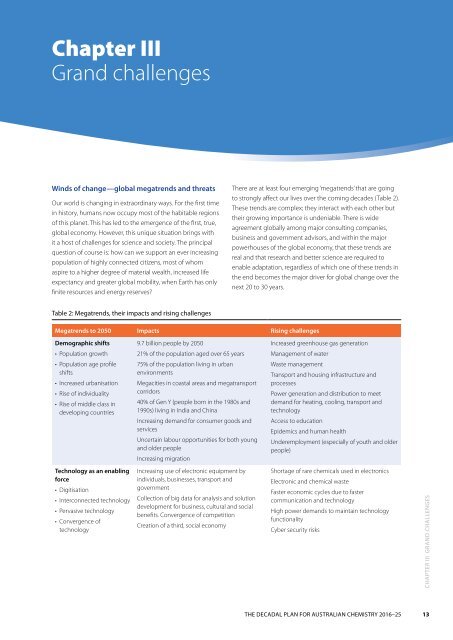Chemistry for a better life
1OiFLmD
1OiFLmD
Create successful ePaper yourself
Turn your PDF publications into a flip-book with our unique Google optimized e-Paper software.
Chapter III<br />
Grand challenges<br />
Winds of change—global megatrends and threats<br />
Our world is changing in extraordinary ways. For the first time<br />
in history, humans now occupy most of the habitable regions<br />
of this planet. This has led to the emergence of the first, true,<br />
global economy. However, this unique situation brings with<br />
it a host of challenges <strong>for</strong> science and society. The principal<br />
question of course is: how can we support an ever increasing<br />
population of highly connected citizens, most of whom<br />
aspire to a higher degree of material wealth, increased <strong>life</strong><br />
expectancy and greater global mobility, when Earth has only<br />
finite resources and energy reserves?<br />
There are at least four emerging ‘megatrends’ that are going<br />
to strongly affect our lives over the coming decades (Table 2).<br />
These trends are complex; they interact with each other but<br />
their growing importance is undeniable. There is wide<br />
agreement globally among major consulting companies,<br />
business and government advisors, and within the major<br />
powerhouses of the global economy, that these trends are<br />
real and that research and <strong>better</strong> science are required to<br />
enable adaptation, regardless of which one of these trends in<br />
the end becomes the major driver <strong>for</strong> global change over the<br />
next 20 to 30 years.<br />
Table 2: Megatrends, their impacts and rising challenges<br />
Megatrends to 2050 Impacts Rising challenges<br />
Demographic shifts<br />
• Population growth<br />
• Population age profile<br />
shifts<br />
• Increased urbanisation<br />
• Rise of individuality<br />
• Rise of middle class in<br />
developing countries<br />
9.7 billion people by 2050<br />
21% of the population aged over 65 years<br />
75% of the population living in urban<br />
environments<br />
Megacities in coastal areas and megatransport<br />
corridors<br />
40% of Gen Y (people born in the 1980s and<br />
1990s) living in India and China<br />
Increasing demand <strong>for</strong> consumer goods and<br />
services<br />
Uncertain labour opportunities <strong>for</strong> both young<br />
and older people<br />
Increasing migration<br />
Increased greenhouse gas generation<br />
Management of water<br />
Waste management<br />
Transport and housing infrastructure and<br />
processes<br />
Power generation and distribution to meet<br />
demand <strong>for</strong> heating, cooling, transport and<br />
technology<br />
Access to education<br />
Epidemics and human health<br />
Underemployment (especially of youth and older<br />
people)<br />
Technology as an enabling<br />
<strong>for</strong>ce<br />
• Digitisation<br />
• Interconnected technology<br />
• Pervasive technology<br />
• Convergence of<br />
technology<br />
Increasing use of electronic equipment by<br />
individuals, businesses, transport and<br />
government<br />
Collection of big data <strong>for</strong> analysis and solution<br />
development <strong>for</strong> business, cultural and social<br />
benefits. Convergence of competition<br />
Creation of a third, social economy<br />
Shortage of rare chemicals used in electronics<br />
Electronic and chemical waste<br />
Faster economic cycles due to faster<br />
communication and technology<br />
High power demands to maintain technology<br />
functionality<br />
Cyber security risks<br />
Chapter III Grand challenges<br />
THE DECADAL PLAN FOR AUSTRALIAN CHEMISTRY 2016–25 13


